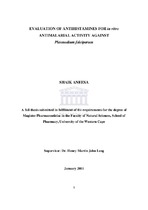| dc.description.abstract | The declining efficacy of antimalarial drugs against resistant Plasmodium falciparum strains in several endemic regions has amplified the world’s burden of neglected diseases. This has highlighted the need for alternate strategies for chemotherapy and chemoprophylaxis. Since malaria is prevalent primarily in third world countries, it is critical for novel therapies to be affordable. Previous research has found that some antihistamines possess inherent antimalarial activity and cause a marked reversal of chloroquine resistance in vitro and in vivo. Promising results have been demonstrated when chlorpheniramine was combined with chloroquine to reverse chloroquine resistance in two African studies (Sowunmi et al, 1997; Abok., 1997).Recently, astemizole and its principle human metabolite desmethylastemizole were identified as potent inhibitors of Plasmodium falciparum at sub-micromolar concentrations in both chloroquine sensitive and chloroquine resistant parasites, showing efficacy in vitro and in two mouse models. The promising results observed with these studies warrant a more comprehensive understanding of how antihistamines interact with the malaria parasite. Additionally, analysing the different structural and mechanistic characteristics of antihistamines may lead to the design and development of effective and affordable antimalarial agents or chloroquine resistance modulators.This thesis describes the antimalarial activity of mainly off-patent (generic) antihistamines by comparing the efficacy of a total of 24 antihistamines, representing histamine1, histamine2, and
histamine3 receptor antagonists, against chloroquine-sensitive and chloroquine-resistant strains of Plasmodium falciparum. Cyproheptadine, ketotifen, loratadine, desloratadine, 3-(1HImidazol-4-yl) propyldi (p-fluorophenyl) methyl ether hydrochloride and ciproxifan display IC50 values less than 4μg/ml. There was no significant difference in the sensitivity to antihistamines among the chloroquine sensitive and resistant parasites tested. A tricyclic nucleus appears to be
an important structural scaffold for antihistamines which exhibit low IC50 values.
Synergistic studies indicate that enhancement of the antimalarial effect of chloroquine on P.falciparum was observed with the ethanolamines against the chloroquine sensitive parasites.Cyproheptadine, ketotifen and desloratadine exerted a marked synergistic action with chloroquine against chloroquine sensitive and resistant parasites. Chlorpheniramine exhibited synergism with chloroquine against resistant parasites only.Microscopic studies illustrate the effect of antihistamines on parasite morphology when compared to control. Using immunofluorescence microscopy, it was seen that ketotifen decreases haemoglobin localization while cyproheptadine increases haemoglobin localization in the parasite’s food vacuole. Western blots have confirmed these results, in addition to indicating that chlorpheniramine decreases the haemoglobin content in the parasite.
The results confirm that certain antihistamines do indeed cause a reduction in the growth of malaria parasites. Furthermore, the histamine1 and histamine3 receptor antagonists are most active while histamine2 receptor antagonists have no antimalarial activity. Microscopic studies suggest that antihistamines do not exert their antimalarial effect via a single mechanism of action.I wish to express my sincere appreciation to the following people and institutions whose supervision and assistance made the presentation of this thesis possible:My supervisor, Prof. Henry Leng. Thank for always believing in me. Your encouragement, kindness and calm temperament has given me the strength to complete this thesis even when times were tough. Your wisdom and understanding will always be remembered.My co-supervisor, Prof. Pete Smith. I sincerely thank you for allowing me the opportunity to work in your laboratory and for welcoming me into the department. Your kindness and welcoming attitude will forever be appreciated. Thank you for always being patient and understanding.Dr. Uschi Wiehart. Thank you for all the help in the laboratory and always being there for me. I truly value and appreciate your contribution to this thesis. Your friendship has added so much positive energy to my life. Thank you for your wisdom, inspirational advice and unfaltering
encouragement Sumaya and Ntokosi, your help, advice and company in tissue culture, are truly appreciated.The UCT, Pharmacology students. Thank for all your assistance.My dearest Pharmaceutical Chemistry colleagues, Jaques Joubert, for your friendship and support and for always listening and Prof. Peter Eagles, your kindness, support and wise advice has given me strength when I needed it most.
To my other School of Pharmacy colleagues. Prof. Sarel Malan and team, for your support and motivation.To my family for all your support and wisdom and to my baby brothers; Omar and Uzair for all the joy that you bring to my life.And finally to my dearest husband, Zaheer for all your love and support throughout my studies and for taking me to UCT to culture parasites every weekend | en_US |

